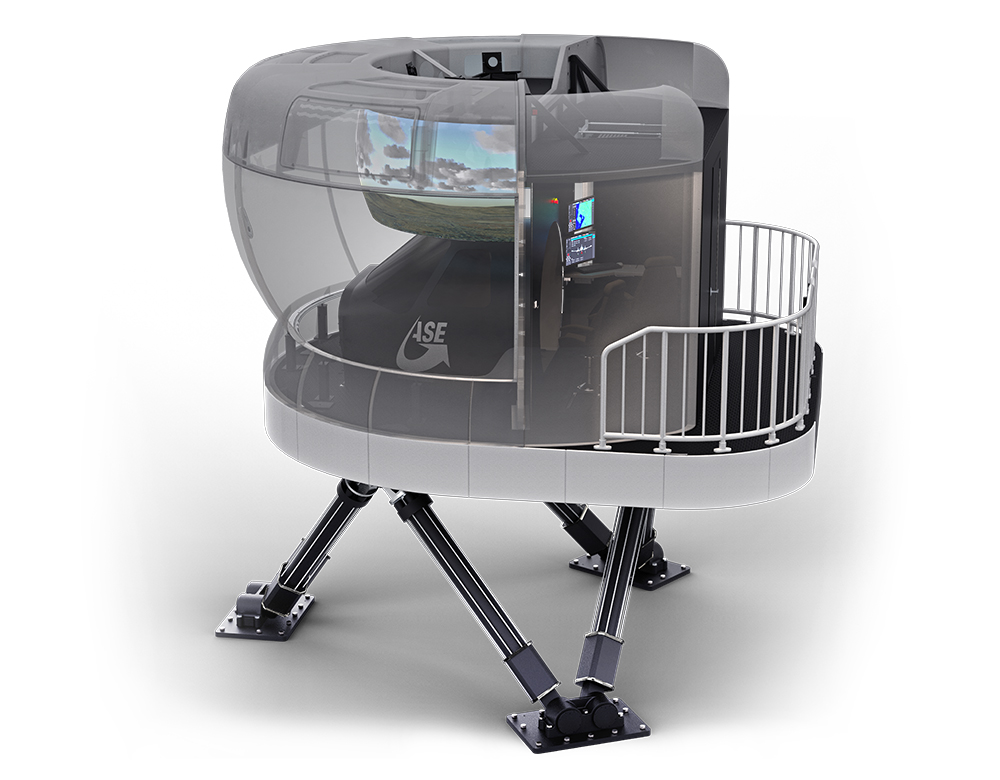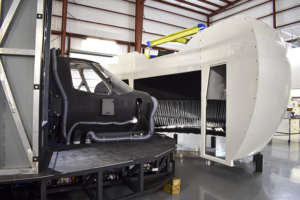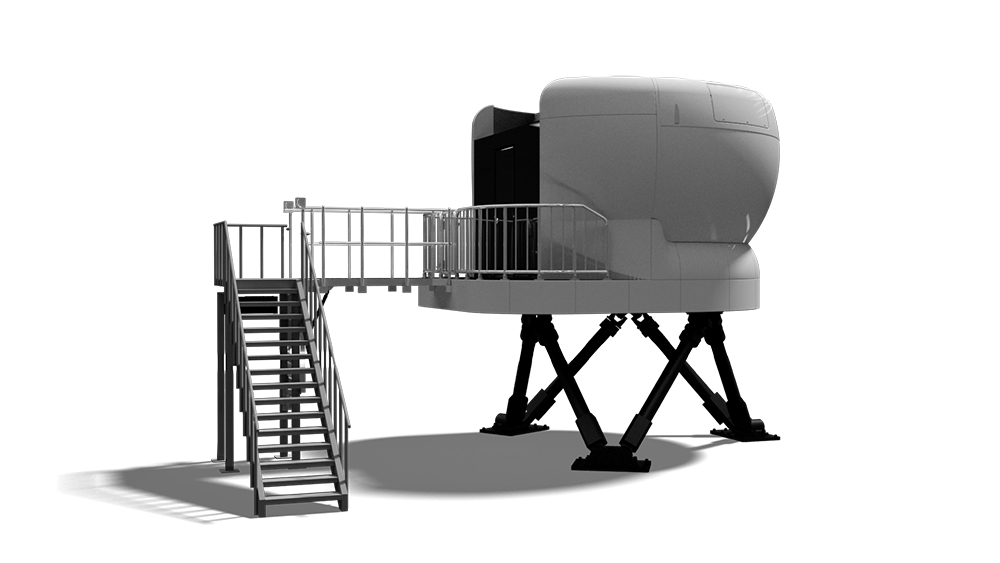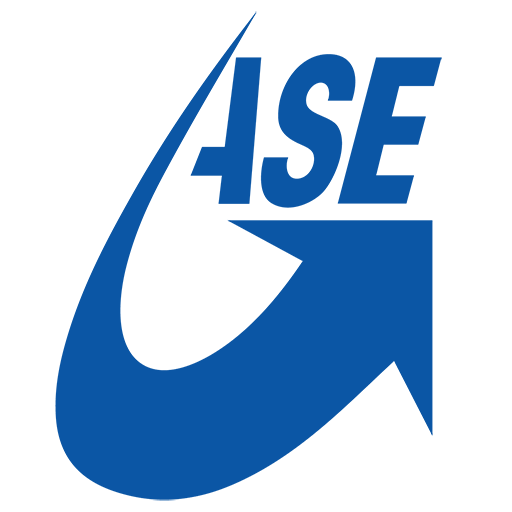Full-Flight Simulators
ASE 2000 Series | Full Motion Simulation
Overview
Full-Flight Simulators from ASE provide high-fidelity training solutions with a cost-sensitive philosophy to help combine value and training efficiency.
The ASE 2000 Series FFS are the business jet solution that provide for excellent flexibility in training of normal, abnormal, and emergency procedures as well as flight maneuvers for initial training, recurrent training, and type rating certification.
For instance, this series, up to Level D, is built to the highest quality and certification standards providing all equipment and software support necessary for ground and flight operations training.
In addition, this full motion package has all of the equipment and computer programs necessary to represent the environment on the ground and in-flight. Moreover, this product line utilizes an electric motion system for a cost-effective solution to a full motion experience.

The Perfect Learning Environment
Full-Flight Simulators:
This next-level training simulator is an exact representation of the simulated aircraft. Simulation at this level has solidified its purpose in the aviation industry for crew procedures training, instrument flight training, transition and conversion training, and recurrent training. Similarly, full size replicas offer the complete hardware, software, and visual system providing an out of the flight deck view and motion system.
Flight Deck
Flight decks of full-flight simulators are specific to a make and model of specific aircraft. Likewise, simulator must have a flight deck that is a full-size replica of the airplane simulated. Certification requires identical functionality and placement of controls, equipment, flight deck indicators, circuit breakers, bulkheads, “eye position”, and suitable location of additional equipment.
Visual System
 Visual Display Systems are one of the critical elements of a simulated experience. In fact, ASE uses the latest in modern visual technology with the EPIC-View D-Series from RSI Visuals. Built for Level D systems, the EPIC-View D-Series meets all Level D Specifications. In addition, the collimated display boasts a 200° by 40° field of view.
Visual Display Systems are one of the critical elements of a simulated experience. In fact, ASE uses the latest in modern visual technology with the EPIC-View D-Series from RSI Visuals. Built for Level D systems, the EPIC-View D-Series meets all Level D Specifications. In addition, the collimated display boasts a 200° by 40° field of view.
Above all, the RSI Visual System brings together low life cycle cost with low cost maintenance. Furthermore, the D-Series integrates motion compatibility in the modern full-flight simulator market.
Motion System
 ASE’s motion and control loading system is built by E2M Technologies. E2M is a designer and manufacturer of 100% electric 3, 4, 5, and 6 degree of freedom motion platform systems with payloads ranging from 500-40,000kgs., electric vibration platforms with 3 & 6 DOF motion, and control loading/forced feedback systems.
ASE’s motion and control loading system is built by E2M Technologies. E2M is a designer and manufacturer of 100% electric 3, 4, 5, and 6 degree of freedom motion platform systems with payloads ranging from 500-40,000kgs., electric vibration platforms with 3 & 6 DOF motion, and control loading/forced feedback systems.
The ASE 2000 FFS motion system supports a fully electric 6 degrees of freedom, designed for use in FAA, EASA Level B and D and ICAO 9625 type VII flight simulation systems for both rotary wing and fixed wing aircraft. In fact, ASE has achieved both FAA Level C and Level D Certification utilizing E2M’s motion and control loading products.


Specifications:
Used for aircraft-specific flight training under rules of the appropriate national civil aviation regulatory authority. Under these rules, relevant aircraft systems must be fully simulated, and a comprehensive aerodynamic model is required. All FFS require outside-world (01W) visual systems and a motion platform with control feel dynamics replicating the aircraft.
Levels for Full Flight Simulators:
FFS Level A (Airplane Only)
- Motion system with at least 3-DOF.
- Basic surface operations must be represented (§60.2.c)
- 300 milliseconds of airplane response 9 (§60.2.g.1)
- Minimum of 1 airport, complete navigation database (§60.3.b.2)
- Minimum Field of View 45° x 30° (§60.6.b)
- Very few Level A Sims in the field
FFS Level B
- Higher fidelity aerodynamic model
- 300 Milliseconds of airplane response (§60.2.c)
- Minimum of 1 airport, complete navigation database (§60.3.b.2)
- Accomplishes most of the requirements for initial type rating but not all, however, satisfies recurrency training with circle-to-land privileges.
- Minimum Field of View 45° x 30° (§60.6.b)
- Very few Level B Sims in the field
FFS Level C
- Motion platform with 6-DOF
- 100 Milliseconds response (Motion and Instrument Cues) & 120 Milliseconds response (Visual System Cues) (§60.2.g.2)
- Must accurately reproduce runway conditions; Dry, Wet, Icy, Patchy Wet, Patchy Icy, and Wet on Rubber Residue in Touchdown Zone
- Windshear, Engine, Airframe Icing, and High Angle of Attack Modeling
- Brake and tire failure dynamics
- Upset Prevention and Recovery Training Requirements
- Minimum of 3 airport, complete navigation database (§60.3.b.1)
- Must accurately simulate the sound of precipitation, windshield wipers, and other significant airplane noises
- Minimum Field of View 176° x 36° (§60.6.d)
FFS Level D
- All standards of FFS Level C
- Must provide motion vibrations that result and can be sensed in the flight deck. (§60.5.f)
- 100 Milliseconds response (Motion and Instrument Cues) & 120 Milliseconds response (Visual System Cues) (§60.2.g.2)
- The simulator must provide realistic amplitude and frequency of flight deck noises and sounds (§60.7.d)
- Simulate motion vibration characteristics (§60.3.f) and limitations such as buffeting with landing gear extended (§60.3.f.2)
- Minimum Field of View 176° x 36° (§60.6.d)
